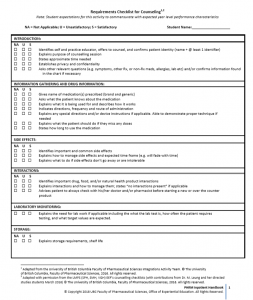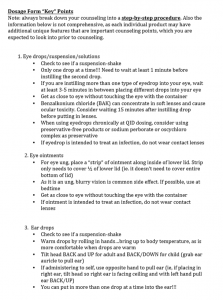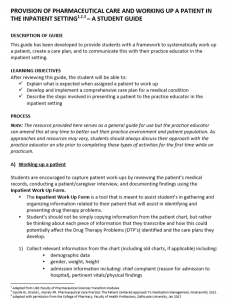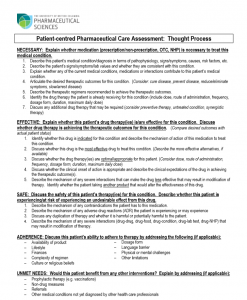What you will find here: UBC OEE checklist outlining components included in standard patient counseling process.
Category Archives: General Practice Resources
General Medication Counseling
What you will find here: UBC OEE guide outlining general components (e.g. Introduction, medication, side effects, interactions, etc.) to assess and include when counseling on medications.
Counseling Key Points for Dosage and Delivery Systems
What you will find here: Example document outlining key points to consider when counseling on various dosage forms.
Please note: Information on this document is not comprehensive as each individual product may include additional unique features that should be mentioned during patient counseling not listed here.
Example Dosage Form Key Points for Different Delivery Systems
Patient Work-up and Monitoring Form Example (Inpatient)
What you will find here: UBC OEE patient monitoring example template for patient assessment, DTP identification, and care plan development. The format and structure of this form is designed to capture a systematic approach to the pharmaceutical care thought process and presentation.
Checklist for Presenting to a Practice Educator (Inpatient)
What you will find here: UBC OEE Patient Work-up checklist that can be used to ensure that all relevant information regarding patient assessment and care plan is captured and presented to practice educator and other health care professionals.
Provision of Pharmaceutical Care and Working Up a Patient (Inpatient)
What you will find here: UBC OEE guide developed to provide a framework to systematically working up a patient, creating a care plan, and communicating this information to a practice educator in an inpatient setting.
NESA and Drug Therapy Problem Categories
What you will find here: Document outlining thought process for patient-centered pharmaceutical care (e.g., consideration for whether a medication is necessary, effective, safe, and patient adherence issues) and Drug Therapy Problem (DTP) categories.
Common Pathogen Treatments and Diagnostic Tips
University Health Network Antimicrobial Stewardship Program.
What you will find here: Treatment and diagnostic tips for the following common pathogens: Gram negative organisms (ESBL, SPICE organisms, Pseudomonas aeruginosa), Gram Positive Organisms (Staphylococcus aureus, Clostridioides difficile), fungi, viruses, and parasites.
- Go to antimicrobialstewardship.com
- Select the relevant resources
Drugs and Bugs Table
What you will find here: One-pager outlining common antibiotic medications and their pathogen coverage.
Please note content is from 2014 and information is subject to change.
Anatomy and Physical Assessments Multimedia Resources
What you will find here: Faculty of Pharmaceutical Sciences Library Weblinks and Multimedia Resources (UBC Library).








